main: July 2007 Archives
Last week, the Black Rock Arts Foundation coordinated the creation of the Panhandle Bandshell in San Francisco. In part as a recycle advocacy action, the steel armature of the bandshell is sheathed in metal car hoods, decorated with obsolete computer motherboards and backed with a wall of bottles. The project is very collaborative with artists from the Finch Mob and Rebar (The inventors of the Park(ing) project) plus landscape architect Christopher Guillard and structural engineer Mark Sinclair.
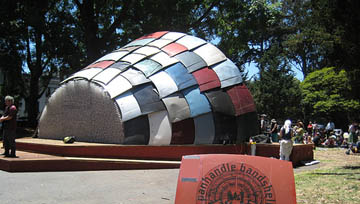
Photo: Mike Love
The making of a single building or other artworks from copies of one mass-produced object occurs regularly enough in both architecture and art. Success occurs when the multiple elements merge into an overall form producing a new tactile surface. In the best of circumstances the connotation of both the new form and the old materials heighten the experience of both. Ai Wei Wei's void of a Chinese temple shaped by the discarded traditional wooden door matches the loss of both religion and small houses in the wave of China's construction boom. Sam Mockbee utilized the car windshield as a substitute for stained glass in Rural Studio's 1999 chapel. The windshield is always the most pristine part of the rusting trucks of farm America. In both works by Wei Wei and Mockbee, the repeating form is fun to examine in the new light (literally and figuratively)
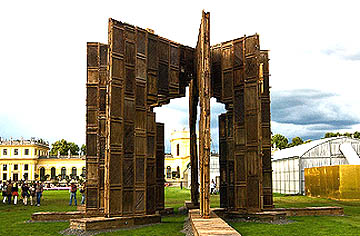
Ai Wei Wei archway of Chinese Wooden Doors, 2007
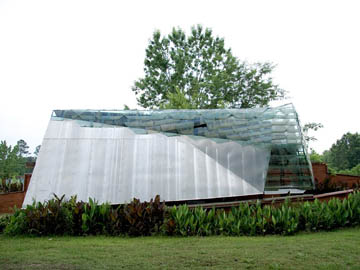
Windshield Chapel, 1999, Auburn University Rural Studio, Samuel Mockbee
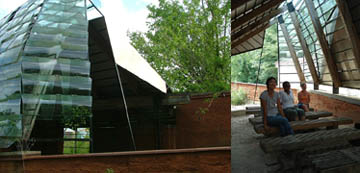
Car Windsheilds and Rammed Earth Walls
The Panhandle Bandshell fails to become something else. The artistic imagination is not sparked. The car hoods are just car hoods from the junkyard stacked in a new location in a mathematical pattern. The lyrical, personal choices of the artist are missing.
I don't see the relationship between bandshell and car hood, except for the possible percussion sounds in the rain. Start to imagine that musical possibility with different sized hoods with different methods of attachments such that multiple tones are produced in the rain. Imagine the long armed wooden mallets hanging inside to "play" the bandshell like steel drums. As the bandshell is played, it might develop the missing lumps of life
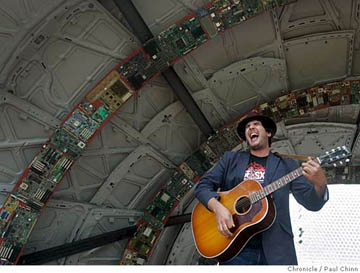
Photo Paul Chinn
Make your Reservations for Burning Man
August 27-September 3, 2007 Black Rock Desert Nevada
Just North of Reno
Also sponsored by the Black Rock Arts Foundation, Burning Man must be an amazing event of visual arts and performance. I wish I could attend.
Temporary Black Rock City at Burning Man. Thousands of tents in an arc. Photo: Maurizio Niccolai
An artist based non-profit in Toronto, Them.ca, has proposed a new funding source for public art. They have done the research and art lobbying. Maybe they will be successful. Who knows.
From the Press Release
Them.ca proposes a charge of $6.00 per sq. foot of billboard space per year. Those funds will then be redirected towards public art. Thus, five 15'x25' billboards could subsidize one small art piece for the cost of $10 000.00 (allowing $1250.00 for administrative and maintenance expenses incurred by city and granting bodies). On a larger scale, the estimated 5000 billboards in Toronto could generate six million dollars for public art per year.
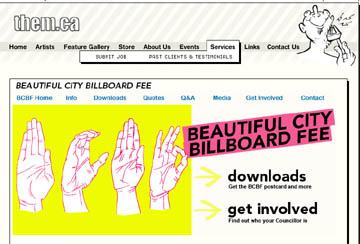
Congratulations to Indianapolis Public Art program and the director, Mindy Taylor Ross. They were the first to start an online system of video podcast interviews with artists and tours. Now they are the first to master the new Google map programs. Very easy navigation of the city to find public art by geography, type and artist. Will they become the first to succeed on "iphone" integration with cell phone tours, visuals, directions and videos? Where is Seattle, Portland, San Francisco and San Jose?????? Click Here for Aesthetic Grounds Research on Cell Phone Tours
Indianapolis copied many of the attributes of the outstanding State of Colorado website including the best resource page with every civic document and instruction to install a work of public art. The new and future works have a viewable image size and short intelligent text - something usually missing on image websites.
Indianapolis site design was supported by the National Endowment for the Arts. I could not find the site designer.
Colorado site was designed by Spire Media
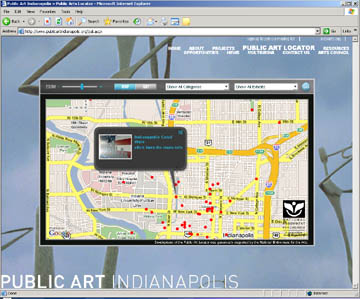
In the UK, Channel 4 has created the Big Art Mob site. The idea is that cell phone users would take photos "on the run" and send them to the Mob site. So far, it is having a hard time attracting users, but you can see the begining of the Google map based photo source of public art for the UK. (You need to register to use the site) The site has the potential for the general public to define "public art" - an excellent idea.
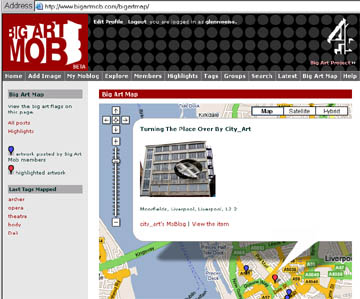
What happens to sculpture in the real world of time and history? The Serra exhibit reminders me of all the discussions that I had with Tom Finkelpearl and Kyong Park during the Storefront for Art and Architecture exhibition on the Titled Arc in 1985. Serra's sculpture was precisely made for the site, but what would happen when the site changed - the front door relocated or even the buildings demolished? If the site was essential to "Titled Arc" as Serra claimed, then the work was bound to be destroyed when the world changed around it.
Finally after 30 years in the USA, the public art profession firmly knows its responsibilities for artwork maintenance. But what about context maintenance? How much responsibility exists for placing the work as it was intended? Once this is impossible as the context mutates or the artwork must be moved, how do we think about it?
The most famous is Michelangelo's David. People know the work from the protected museum setting, not the outdoor plaza where the scale and role of the work is much different. Almost every art history book presents the work with even light and white walls, not the harsh sun and rough stone of the palazzo.
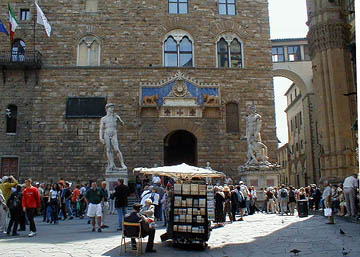
Fake David with Bandinelli's Hercules at Palazzo Vecchio in Florence
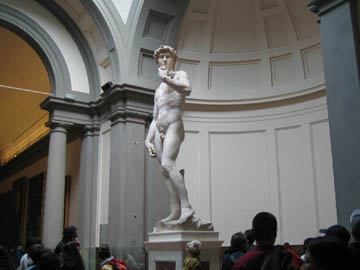
Real David Indoors with a museum neutral background
This sculpture in Montreal has entirely different feeling when examined against the early 20th century beaux art building. Here the sculpture blends with and accentuates the attributes of building. Juxtaposed (I bet the sculptor never considered juxtaposition - now a bedrock of contemporary public art reality.) with the 1980s glass, the artwork is a sweet, decorative music box.
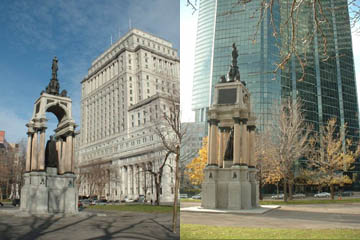
Montreal
At the Aesthetic Grounds visual essays site, I have posted some other comparisons. Some are photographing the same work with different back drops. Other such Aristide Maillol, "River" or Jonathan Borofsky's Hammering Man, the reproduction of the work creates opportunities for comparison around the world.
The original installation of the artwork is only phase one in a potentially long history. The protectors of contextless objects in the museum, universities and galleries have no mandatory interest in the context driven public art. Therefore, the public art field needs to build its own intellectual methodology as all other institutions have a vested interest in ignoring the meanings and connotations of physical context.
See the CONTINUED text for documentation and Chris' excellent observations regardin moved art in Philadelphia on Chris Purdom's philart.net. Report on July 26, 2007
http://www.creativetime.org/programs/archive/2007/one_day/The official public art chance of a lifetime for less experienced artists. For the cost of a little paint and one day of your life, seven artists transformed 1970's bus shelters on the main street of one of the most liberal towns in America, Madison, Wisconsin. Painted on July 1, the shelters will be demolished starting on July 29, 2007.
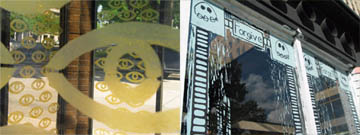
Darryl Jensen and Craig Grabhorn
Some of the artists created middle of the road projects to further their credentials for public art commissions. You can tell because they "stayed within the lines". Two artists transformed the shelter: Nina Bednarsky with a line of tall grass and Craig Grabhorn with a gentle Tim Burton house of horrors.
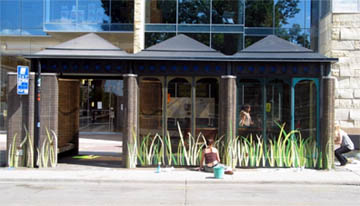
Nina Bednarsky
Psychologically and literally, "staying within the line" is part of the contemporary practice of every specialist constructing our cities, but artists have a responsibility to mess up the borders. Many times the artistic instincts of a 5 year old are better than a 12 year old.
Craig Grabhorn
Destination was organized by artist Melanie Kehoss. (All photos by Kehoss) Kehoss did try something I had not seen before. She set up phone numbers so that on site cell phone users could call and listen to the artist's explanation of the work. If any one knows of other cell phone use with voice or text, please let me know.
See the CONTINUED text for more information on using cell phones from Madison and Creative Times' 2007 New York City project.
I started with the idea to compare multiple flickr photos of the Richard Serra's sculptures at MOMA in NYC this summer. If you are interested, visit the 436 pictures on The MOMA Project. Favorite shots by the amateurs and professionals: Sky/buildings cut by curving steel line, walkers in a tight linear space, full body portraits against the rusting steel and kids when available.
The real advantage of the blockbuster show in the New York (the center of traditional media) is the vast quantity of writing, not pictures. All the major New York critics have spoken and the bloggers' thoughts pour onto page after page.
Both bloggers and critics think the show is fantastic, No reservations are expressed except by a few young artists that think it's just old stuff without contemporary merit.
Universal praise from critics comes from two things: 1. the determination of Serra over many years to really figure out the power of these steel plates and the spaces they make. And get better and better at it. 2. the assumed fact that the works are unique - a rare commodity in art, architecture and design. With the huge cost and technical knowledge required, no one else can shape INDEPENDENT massive steel plates like this. As Michael Kimmelman notes in the NY Times, what is a better American compliment than "You have never seen anything like this before"? (my sentence)
No one is stepping back from the applause to ask "Why now" and "Who else". For why now, Peter Schjeldahl in the New Yorker implies the work has contemporary value as a passionate tactile counter-revolution against the virtual world and electronic art. For who else, in New York Magazine Jerry Saltz makes the connection to Frank Gehry's shapes and credits Serra with influencing him (Doubt he verified the truth of it.)
To me the "why now" is forty years of artworks in museums and public spaces that has produced an audience that knows that art can be anything. "Is it art?" is assumed and the audience just attempts to get out it whatever it can. For the critics and bloggers alike, the amusement park bodily experience dominates in the endless tunnels and optical confusion caused by slightly tilting walls at multiple angles. Many report dizziness. Both Kapoor in Chicago and Eliasson in London have achieved popularity with full body involvement.
Despite the removal of "Tilted Arc," Richard Serra may be the first artist to gain popular acceptance due to public art. I cannot imagine anyone but a child interpreting Serra without the experience of thousands of sculptures in city plazas, parks and sculpture gardens across the USA.
In my early 20s, traveled from Pakistan through the Indian Punjab visiting the palaces and mosques of the 15th and 16th centuries. When I got to the Taj Mahal in Agra, I cried tears. As a future architect, I knew that one person could never design such perfection. Only a culture committed to beauty could imagine the Taj. I was cursed as I came from a culture that prizes the individual and that ignores beauty. No Taj Mahal in my future.
Perhaps Serra lifts the black mark. But not by praising his notoriously arrogant individuality as is so prevelant among critics that know Serra or feel sorry for his trials. Rather ignore Serra as the person and see him as the start of a wave of artists. Artists now have a substantial cultural history in the USA that matches the consistency of 16th century India. Like the architecture he admires, Hagia Sophia in Istanbul and Borromini in Rome, his work is possible because he is the second or third generation. Others have been working before him and with him.
Therefore the "who else" is not individuals, but the consistent artworld that was developed after WWII. They are all in Serra's work - Judd, Andre, Morris, Turrell, Holt, Berg, Lewitt, Aconci, Eisenman, Gehry, Kiesler, Graham ,,,,, on and on and on. As the boomers age, we may have this final baroque modern of joyous maturity. I think in fifty years some other artist will cry when experiencing Serra and lamenting the impossibility of the artistic collaboration in the decentralized world.
The Writing
From a writing perspective, the most interesting phemenoem is descriptions of critics and bloggers. Everyone is seeking the right way to describe the work through comparison to other memories from common human experience. Clement Greenburg must be suffering AGAIN to see all the scientific art jargon gone. Art criticism is merely good description, not the exploration and development of a precise artists language. Coming with Serra, whose original work grew from the intense art language, it ironically demonstrates the final demise of art criticism as an field of study. But art criticism is now fun the write and read.
Go to the CONTINUED entry for comparitive quotes and link to several articles. Be sure to the read the Artopia review on Artsjournal.com.
Sign up for the Monthly email that lists the Aesthetic Grounds essays and links.
In Hamburg in 2004, Zoll-Douane art in public places exhibition asked 30 artists to create works about boundaries - mainly national ones after the unification of the European currencies. Artists Anja Steidinger and Raul Cordero projected the image of two people waving on the exterior wall at the entrance/exit of the exhibition. "Goodbye/Hello" presents the ambiguous gesture - waving - in which the meaning is established by the context. Waving goodbye, waving hello, waving for attention.
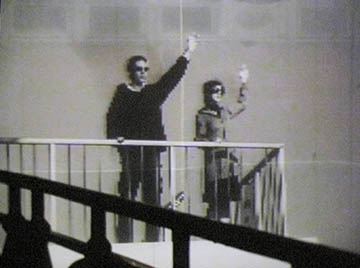
Goodbye/Hello projection by Anja Steidinger and Raul Cordero
Years ago in an Agnieszka Holland film (I think), a series of faces were flashed on the screen and the imaginary audience selects if the face is happy or sad. All the faces were neutral like the ones below. The scientists were testing the audience, not the meaning of facial expressions.

Happy or Sad?
Ambiguity is loved by the fine arts and generally rejected by the public arts. We Americans are trained in the good, bad and purposeful. Ambiguity requires self-awareness by the viewers to explore their own reaction. Americans match their feelings to the feelings of the artwork, not explore. We judge the feeling. Ambiguity has no place.
.
.
.
Sign up for the Monthly email that lists the Aesthetic Grounds essays and links.
In 1968, Atsuko Tanaka created a large pink square of fabric floating over the grass. This summer the pink plane was re-created at Documenta 12 in Kassel.
In Austria, another square pink will be constructed as a shallow pool in 2007. The "Der Rosa Platz" by Hans Kupelwieser is the Monument for Homosexual and Transgender Victims of the Nazi Regime in Austria. The letter "QUE(E)R" will rise from the pool as stepping stones. The Art in Public Places of Vienna website states that the work refers to the pink triangle used by the Nazi's to designate homosexuals. The pink water will reflect the surrounding buildings in a pink tone.
One pink square is without defined meaning. One pink square labels itself. One fabric. One water. Both pure color, but one flat and the other reflecting. One demands the joy the seeing color. One uses color to celebrate freedom from the past.
Which is better public art? And to whom?
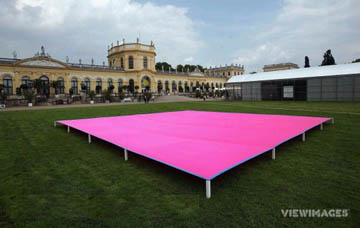
Atsuko Tanaka
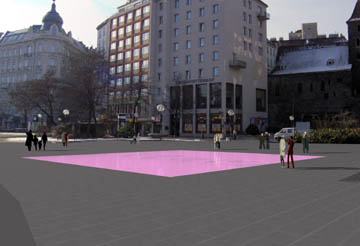
Hans Kupelwieser
Sign up for the Monthly email that lists the Aesthetic Grounds essays and links.
If you missed the opportunity in June, you can still see some small-scale inventions by artist participants in Javier Abarca's workshop on "Spontaneous Public Art". Taught through the Universidad Complutense de Madrid, Abarca formalizes the methodologies of inventions by stressing the link between the immediate context and the artist's addition.
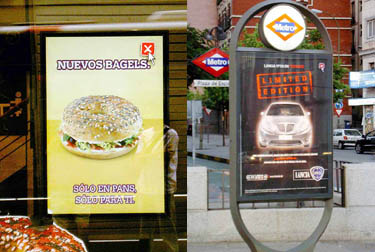
"Close" Project by Santiago Cortizo in Abarca Workshop
A sticker in the upper right corner of the advertizement to "close" it.
Most graffiti artists, poster wheatpasters, advertisement placement buyers and sign designers seek only visibility by the targeted audience. Any relationship with the psychological or connotative implications of the physical surroundings is merely accidental.
Many commissioned public artworks gain strength from context, but negative commentary, irony or rational critique is normally prohibited from realization. As is the "messiness" - (Neatness is one of the few very consistent qualities of commissioned public art). Negativity, irony, critique and messiness are foundations of much temporary interventions from Robert Smithson to John Fekner to Bansky.
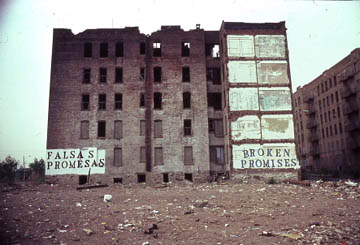
John Fekner's Bronx Project Stencils, 1980
Generally, the willingness to vandalize the public realm - even in minor ways - means the artist will not have a career in American public art. Public artists follow the rules, and the most successful, understand and RESPECT human social organization. If the artist is talented at creating powerful interjections, they are more likely to move into the museum crowd or non-art political action. The exclusion of these artists from commissioned public art is one of the main reasons American public is so tame in the public realm. The visual skills of survival on the street must be tested and practiced. The American public artists need to return to boot camp.
MANIPULATE STREET ELEMENTS
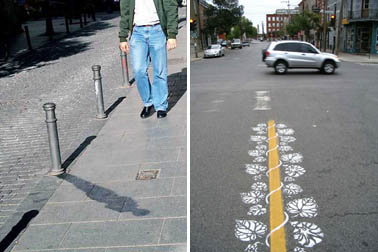
Shadow by Dos Jotas, Madrid and Peter Gibson a.k.a. "Roadsworth", Montreal, photo by marc
The best urban intervention website in WWW.WOOSTERCOLLECTIVE.COM
SILLINESS
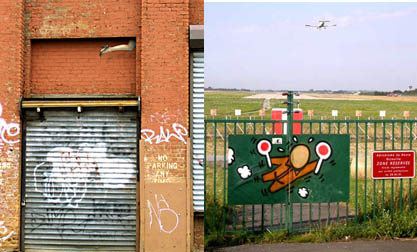
Floating leg by Dan Witz and cartoon airplane flag man at the airport by Jace
HOPING THE AUTHORITIES WON'T NOTICE
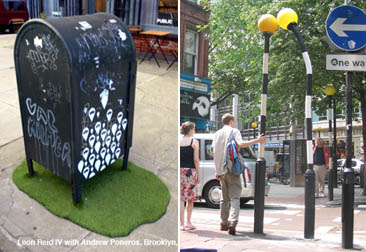
Works by Leon Reid IV. The right leaning lightpost was fake and temporary. Part of Reid's "Kiss" series.
TINY WORKS
Do Not Buy by Abarca and Congregation by Kristi Sword (Candy Sprinkles)
MORE ABARCA
As an expert in typology, Abarca has taken unique sets of photographs of Madrid to understand the amateur application of letters to trashcans and cheap light box signs. Through the hundred photographs, a kind of style emerges in which precision is not important and a lack of forethought forces the maker to modify the letters during the application. One arbitrary placement frequently requires accommodation by everything else. Much more than standard graffiti, murals or signs, the process of making is palpable. The ghost of physical action and mental thinking emerges from the objects like abstract expressionism in slow motion.
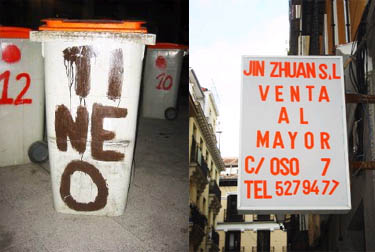
Photos by Javier Abarca in Madrid
Sign up for the Monthly email that lists the Aesthetic Grounds essays and links.
Blake Gopnik of the Washington Post cannot handle the world. He traveled to Venice, Kassel and Munster and concluded the artwork is directionless, an attribute that according to Gopnik fits nicely with the marketing of art. No artist is out. Everyone is equally for sale.
I don't want to be as flippant with Gopnik as he is with three serious artworld events. Rather than stress his apparent sadness over the loss of a single direction of progress in art (an idea that I thought had already died), he might have better directed his comments toward curators that failed to present a point-of-view. The silence of the NY Times critics on the overall impact seem to verify Gopnik. Michael Kimmelman very gingerly comments that the Venice show is a "little boring" and curator "Robert Storr's choices seemed risk-averse".
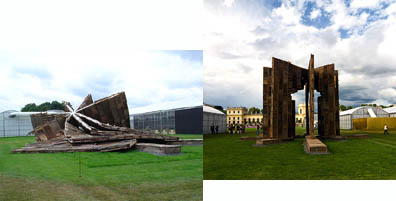
Ai Wei Wei at Documenta - After and Before the Storm
From my CRT in Delray Beach, I depend on flickr to bring me the images. Photographers on flickr are most attracted to the following. In Munster: a big flower, a giant ball of crushed fiberglass "cows on parade" and miniature sculptures on a lawn. In Kassel, nothing. Ai Wei Wei's sculpture collapsed in a freak rainstorm just after the opening. The stuffed dogs ready to be judged in the dog show and the gently waving mylar gains a photo or two. From the flickr group, Munster totally crushed Documenta who apparently forgot to show up to the public art contest on the street. Perhaps Documenta succeeded better indoors.
Munster built a website that provides simple access to images and text about the works through posting all their press materials. Documenta and Venice seem to have no interest in the online audience. I would complain even if I had been in Europe. As I try to demonstrate with the paired pictures below, the online digital imagery allows the viewer to make connections among the works. Rather than complain like Gopnik, the critic has the responsibility to write two reviews: one the "performance" of the temporary exhibition created in the city or space by the curator and the other that links between works that did not inhabit the same room or nation. And every curator should release the exhibition toward a powerful performance by teaming with an internet librarian.
Gopnik does assault something personal to me: the word "aesthetic". He seems to think the word means pretty or beautiful. I thought "aesthetics" was the philosopher's term for the thoughtful exploration of the arts as a phenomenon of human nature. No matter the definition, Gopnik is striving to retain meaning as the core value of the arts rather than pretty colors (that look good over the couch.) But those powerful new meanings come from a cultural need to renovate our ethical foundations to conform to the unintended consequences caused by the reality of human creation. Today the artists that use meaning are frequently just a decorative as the decorators. They easily repeat the conceptual act of Bueys just as a painter repeats the color of Matisse. As I hope to explore in more essays, public art may better tools to create meaning than the gallery and museum universe.
ORDERED, COLORFUL JUNK WITH A HISTORIC BACKDROP
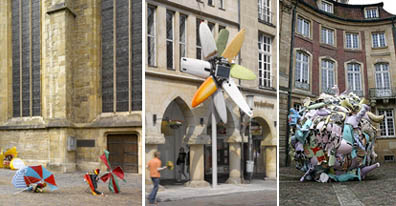
Munster Three: Genzken, Lahanka, Siekman
Genzken Photo: Roman Mensing, Siekman Photo: Blake Gopnik
THE ARTIST'S DREAM OF SADNESS
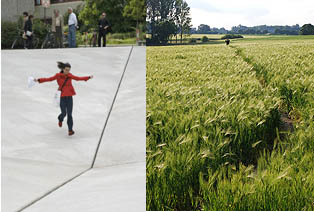
Munster: Naumann's 1977 negative pyramid and Althamer's 2007 path to emptiness
Naumann Photo: Arendt Mensing Althamer Photo: Roman Mensing
MAGAZINE GRAPHICS IN THE LANDSCAPE
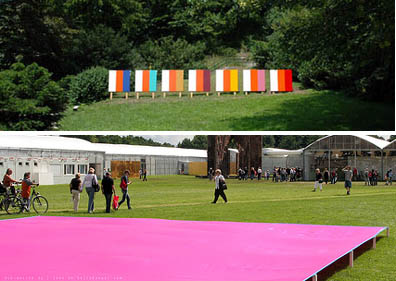
Documenta Pink & Green: Gernes 2007 strip and Atsuko's 1968 canvas
PRETTINESS FROM FILTH.
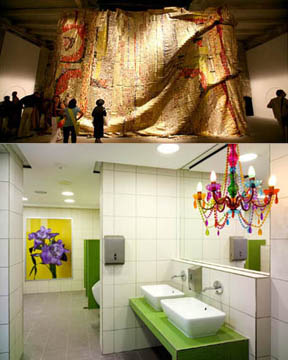
Venice's shimmering bottlecaps by El Anatsui and Munster's pretty public restroom by Feldmann
Anatsui Photo: Librado Romero Feldman Photo: Arendt Mensing
TWO METAPHORS FOR THE PRISONS OF THE LANDLESS
In Venice: International Razer Wire Camps by Abdessemed and Brazilian Ghettos by Dias
Photos by NY Times
STRIVING FOR DENSE SPACE
Flowing room by DeFreitas in Documenta and crushed room by Sosnowska in Venice
DeFreitas Photo: akikouki Sosnowska Photo: NY Times
DON'T WE ALREADY KNOW THE POWER OF REPRODUCTION?
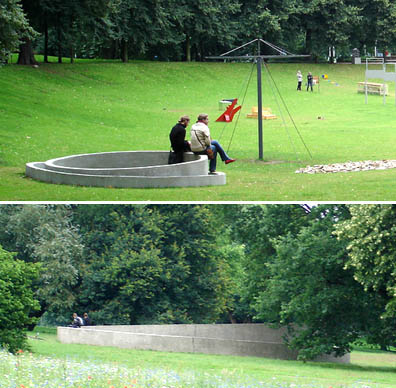
In Munster: Little Mini Judd by Gonzalez-Foerste and Judd by Judd
Judd Photo: akikouki
MY FAVORITES
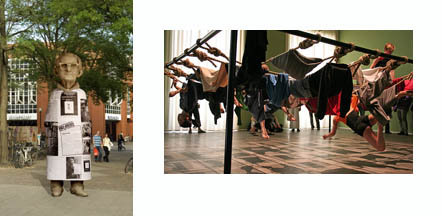
Wagner's pain-in-the-ass man in Munster and Brown's wiggle gym at Documenta
Wagner Photo: Sarah Bernhard
RESOURCES
Flickr Group on Documenta (The official Documenta website is only slightly better than the totally useless Venice website)
Documenta Blog with In-Progress photos of lectures and performances
The Munster website is excellent with photos and descriptions of every work. Click Here
Good Munster Photos by akikouki and STFE
ARTISTS
Question: Why don't well-known artists have websites? Is it snobbery? So far I have found only one website.
Adel Abdessemed
Isa Genzken
Peter Feldmann
Marko Lehanka
Pawel Althamer
Dominique Gonzalez-Foerster THIS IS HER WEBSITE
Poul Gernes MADE BY OTHERS
Trish BrownHER, BUT PLACEHOLDER
Ai Wei Wei HIS, BUT POOR
Bruce Naumann FAN WEBSITE
Monika Sosnowska
Iole de FreitasTHIS IS HER WEBSITE
Atsuko Tanaka
Click for Full Blake Gopnik text from Washington Post, July 8, 2007
Download file
Sign up for the Monthly email that lists the Aesthetic Grounds essays and links.
As iphone fever overwhelms the electronic toy collectors, we all need to get serious about a future without privacy or distance in the classic sense. We remain tethered to everyone: lovers, friends, strangers and computer generated messages. What excuse do we have to cut ourselves off and take a break?
I am sure that many, many artists have been making works for cell phones for a while, but this week I discovered the Festival of Pocket Films held in Paris in early June 2007 for the third year. All the video was shot with a cell phone and designed to playback on the cell phone. Below are a few that I liked with the link to the video. Start with Tic Tac Toe by Matthew Swanson of Vancouver, Canada for a little smile.
The tiny video works that interest me contradict the notion of constant connection and communications. These videos grab moments in the city when we are private in our heads despite our full immersion in urbanity. Is this the future? Even with some private territory in an apartment, will only mental privacy survive in the megacities? When the cell phone provides an avenue for almost anyone to enter your space, are these short mental moments of isolation the new reality of intimacy?
Reserve Love and Free Run capture the joy of movement among urban streets. One is a brisk walk toward a meeting with a lover in Paris. The other is an imaginary run and jump and skate with the flow of the city of London at all scales. Joy makes the world feel like an out-of-focus river. The world is present but never with you.
Brother and Sorrow capture moments of pain in the city when a person is self-isolated in sadness or depression. Background people move in mass, but the single character does not interact and attempts to remain motionless while moving. Unlike joy, in sadness all the little details of the place receive a linering, focused observation.
All the works are developed for the cell phone - the instrument of connection. But these films are viewed when the phone itself is used to make a private moment. A short break of intense consentration on a tiny image. The destroyer of traditional privacy has the capacity to encourage the new privacy of living inside your head.
Free Run by Henry Reichhold, UK
Imaginary run through London with the city flying by.
"Reverse Love" Still
Reverse Love by Morgan Foldi-Mohand
Pleasant view of the ourselves enjoying the street with private music
Brother by Kerim Bersaner, The Netherlands
The narrator describes his pain of the loss of a brother while images of Chechnya's destruction and of her mothers move in a crowd or alone in the street.
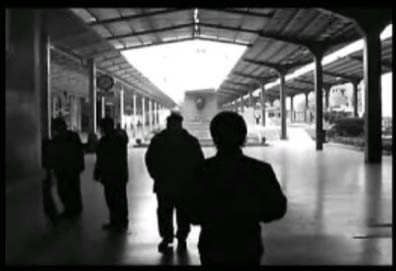
Sorrow Still (Istanbul Train Station)
Sorrow: D'A.Betil, D. Buga, O. Karaglu, Turkey
Private internal space or sorrow while riding the train and ferry
These two works below I highlight for the flattening of space: literally and in the Thomas Friedman world. Tracking Transience takes you around the world in 120 seconds with a generic urbanity, maps, urinals where only the plates of food spark any locality, (yet these plates are available in any city with immigrant restaurants.) Carscapes turns San Paulo into any concrete city and with uncongested freeways during part of the day.
Tracking Transience by Hasan Elahi, USA
Tour the world in 120 seconds with streets, food and urinals
Carscapes by Giselle Beiguelman, Brazil
Fast clips of urban San Paulo from the car window
Blogroll
AJ Ads
AJ Blogs
AJBlogCentral | rssculture
Terry Teachout on the arts in New York City
Andrew Taylor on the business of arts & culture
rock culture approximately
Laura Collins-Hughes on arts, culture and coverage
Richard Kessler on arts education
Douglas McLennan's blog
Dalouge Smith advocates for the Arts
Art from the American Outback
For immediate release: the arts are marketable
No genre is the new genre
David Jays on theatre and dance
Paul Levy measures the Angles
Judith H. Dobrzynski on Culture
John Rockwell on the arts
Jan Herman - arts, media & culture with 'tude
dance
Apollinaire Scherr talks about dance
Tobi Tobias on dance et al...
jazz
Howard Mandel's freelance Urban Improvisation
Focus on New Orleans. Jazz and Other Sounds
Doug Ramsey on Jazz and other matters...
media
Jeff Weinstein's Cultural Mixology
Martha Bayles on Film...
classical music
Fresh ideas on building arts communities
Greg Sandow performs a book-in-progress
Exploring Orchestras w/ Henry Fogel
Harvey Sachs on music, and various digressions
Bruce Brubaker on all things Piano
Kyle Gann on music after the fact
Greg Sandow on the future of Classical Music
Norman Lebrecht on Shifting Sound Worlds
publishing
Jerome Weeks on Books
Scott McLemee on books, ideas & trash-culture ephemera
theatre
Wendy Rosenfield: covering drama, onstage and off
Chloe Veltman on how culture will save the world
visual
Public Art, Public Space
Regina Hackett takes her Art To Go
John Perreault's art diary
Lee Rosenbaum's Cultural Commentary
Tyler Green's modern & contemporary art blog
